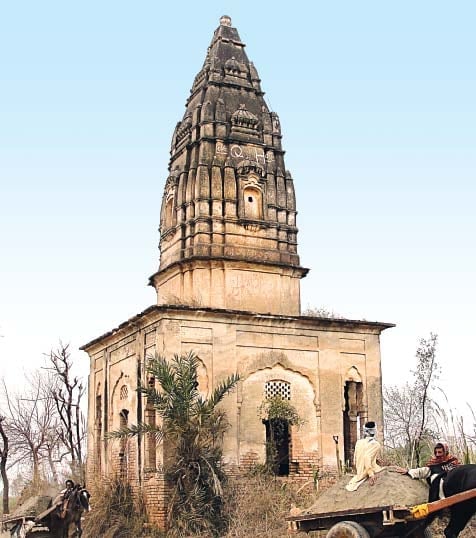
There are six temples in the mohallas of Sheikhanwala, Nagianwala, Baoliwala, Khawjgan, Chirih Chong and Gangwala Darwaza. Three of these have only their ruins visible above the ground. The other three still stand but their buildings are crumbling. No civic body is looking after these monuments except a retired army officer Col (retd) Zahid Mumtaz who is working on the cultural heritage of Bhera town.
The Baoliwala, Sheikhanwala and the Shiva temples are the most impressive structures that have withstood the vagaries of weather. The Baoliwala Mandir lies on the road that leads to Jhelum River. The elevated pinnacle of the temple is visible from a distance. The temple lies deserted but for the lower part where the idol of the deity was once placed (garbhagirha). But this too is in bad state of preservation. The temple has three openings from four directions. It has also the basement cells where the pujaris or the temple priests lived. There is a pradakshina (circumambulatory gallery) around the garbhagirha. On top of the entrance gate there is a gaping hole where once the temple’s inscription tablet may
have been.
The entrance gate of the temple is in ruins. The stairways leading to the main chamber of the temple are all broken. Now, the main chamber (garbhagirha) is a heap of debris. The shikhara (superstructure) of the temple is still in good condition but the niches where the murtis stood are only just noticeable.
Another Hindu temple is located in Nagianwala Mohallah. This temple is dedicated to Shiva, the Hindu god of destruction whom the Yogis worship to annihilate their ego. The temple is believed to have been built by the Nath jogis who are the Shivite renouncers and take the Shiva as their first guru. The jogis were famous for their ascetic practices to kill their ardour (tapas).
The region of Potohar was the centre of the jogis with their main headquarters situated at the Tilla Jogian in Jhelum District. There are many places in Potohar region which are associated with jogis. One such place is the Bagh Jogian in Islamabad where there are some structures, probably Samadhis (now destroyed) of Nath jogis. Another famous space of Nath jogis is the Samadhi of Baba Budh Nath Jogi at Makhad in Pindi Gheb Tehsil of Attock District.
The Shiva temple has eight Samadhis of the Nath jogis on the podium of the temple. Nath jogis buried their dead near their homes or in the temples instead of cremating them as is the custom of other Hindu denominations. Their place of burial is called a Samadhi, the final resting place of those who have renounced the world. The Nath jogis wore ochre colour cloths called ‘bhagva’ from which the name of the town Bhera may have originated.
The distinctive feature of the temple is the mandapa (columned hall that precedes the main chamber of the temple). The pillars of the mandapa are decorated with the images of Shiva in yogic postures. One of the pillars of the temple is also decorated with a painting of Brahma. The temple is built on an octagonal plan superimposed with a dome that gives it the looks of a Muslim tomb.
The third temple in the Sheikhanwala Mohallah is noted for its elegant shikhara. It is a square building. One only wishes the concerned authority could do something to restore these temples as relics of our past. But Lord Shiva still seems to be doing his job and he may not be interrupted.
The author is Research Anthropologist at Pakistan Institute of Development Economics (PIDE), Islamabad. He may be contacted at zulfi04@hotmail.com
Published in The Express Tribune, February 11th, 2011.























COMMENTS
Comments are moderated and generally will be posted if they are on-topic and not abusive.
For more information, please see our Comments FAQ